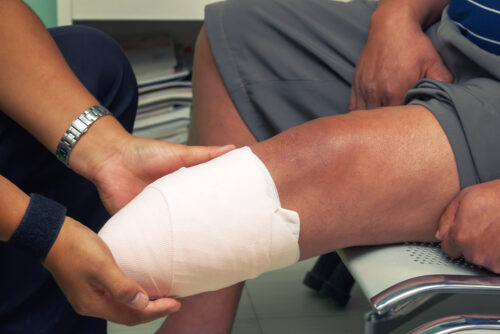Offshore Amputation Injury Lawyer in Houston, TX

Did you or a loved one suffer an injury resulting in amputation in an offshore accident near Houston or anywhere in the Gulf of Mexico? If so, you or your loved one could be entitled to compensation for the harm suffered, from the pain of the injury itself to the cost of medical treatment, the long-term limitations it causes, disfigurement, and other benefits.
The offshore amputation attorneys with The Callahan Law Firm want to help you pursue the financial security you need during this difficult time. Contact us today for a free case review to learn more about your legal rights and the potential value of your claim.
Why You Need Our Law Firm After a Maritime Limb Loss Injury
If you lost a limb in a preventable offshore amputation injury, you deserve the best legal help available. The lifetime cost and impact of an amputation injury are considerable, but you could be entitled to compensation under general maritime law, the Jones Act, and/or the Longshore & Harbor Workers’ Compensation Act. Getting this compensation may prove difficult without help from an experienced personal injury attorney.
The Callahan Law Firm has secured tens of millions of dollars in compensation for injured people in Houston and the surrounding region. We’re here to help you by aggressively handling your case and pursuing the maximum compensation for the full extent of your losses. Our team has successfully represented offshore and maritime workers over many years, and we’re ready to apply our considerable resources and skills to your case.
What Is an Offshore Amputation Injury?
An offshore amputation is a permanent, life-altering injury where an offshore worker suffers the loss of all or some of a limb, digit, or other extremities. Offshore workers are especially vulnerable to amputation injuries because of the dangerous nature and conditions of their work.
Some common types of amputation injuries that affect offshore workers include:
- Partial hand amputations, which remove part of the hand, or all or part of the fingers
- Metacarpal amputations, which remove the entire hand at the wrist
- Wrist disarticulations, which remove the whole hand and the wrist
- Transradial amputations, which remove the arm below the elbow
- Elbow disarticulations, which remove the forearm at the elbow joint
- Transhumeral amputations, which remove the arm above the elbow
- Shoulder disarticulations, which remove the arm and shoulder blade
- Partial foot amputations, which remove part of the foot, or one or more of the toes
- Ankle disarticulations, which remove the entire foot at the ankle
- Transtibial amputations, which remove the leg below the knee
- Transfemoral amputations, which remove the leg above the knee
- Hip disarticulations, which remove the entire leg below the hip joint
- Hemipelvectomies, which remove the whole leg and some of the pelvis
Types of Offshore Accidents That Commonly Result in Amputations
Offshore accidents that can lead to amputations include:
- Entanglement accidents – Offshore workers can get their limbs or digits caught in tow lines, chains, or cables. The resulting entanglement can restrict blood flow and cause necrosis or forcefully snap or pull body parts off.
- Fires and explosions – Offshore workers often spend their time around oil, gases and other flammable substances. As a result, they are at risk for exposure to fires and explosions, which can cause extensive burns and possible amputation injuries.
- Crushing accidents – Heavy equipment, machinery as well as objects falling from heights can destroy limbs with brute crushing force.
- Struck-by accidents – Struck-by accidents occur when falling or flying objects collide with offshore workers. The collision can lead to an amputation injury when the object in question is particularly sharp or heavy.
- Falls from heights – Falls from heights are a leading cause of injury among offshore workers.
- Transportation accidents – Transportation accidents involving tug boats or barges can contribute to amputations if offshore workers get their body parts caught in between colliding vessels.
Treatments for Limb Loss and Ongoing Impairments
Maritime and offshore workers who suffer traumatic amputations and limb loss often experience life-changing health implications that require costly, long-term treatment. According to the American Medical Association, the projected lifetime cost of the direct and indirect medical expenses from an amputation averages more than $1 million.
Common costs associated with amputation injuries include expenses for:
- Initial emergency treatment, hospital stays, and surgical procedures
- Osseointegration, the insertion of steel implants into amputated bone ends
- Rotationplasty, the removal of dead tissue and reattachment of healthy tissue
- Pain management therapies for residual limb pain or phantom limb pain
- Treatment for complications, such as skin infections or muscular atrophy
- Mobility assistive devices, such as canes, walkers, crutches, and wheelchairs
- Durable medical equipment like shower chairs and grab bars
- Initial prosthetic device prescriptions, fittings, and fabrications
- Routine repair and replacement expenses for prosthetic devices
- New prosthetic costs as needs and functional abilities evolve with time
- Rehabilitation therapies to relearn walking and other daily activities
- Mental health therapies to cope with the psychosocial effects of limb loss
Liability for Amputation Injuries Suffered by Maritime and Offshore Workers
Depending on the circumstances of the accident, you may be entitled to pursue compensation for injuries under several legal theories.
For example, a maritime worker who is a seaman and suffers amputation injuries aboard a vessel may have a valid claim for compensation under the Jones Act. The Jones Act gives injured maritime workers who are members of the crew of a vessel the right to seek compensation and benefits for amputations that happen due to the negligence of the vessel’s owner, the vessel’s operator, another employee of the owner or operator, or the marine employers for their employee’s work-related injuries.
A successful Jones Act claim for a maritime amputation injury could provide benefits such as:
- Medical care
- Living expenses during the period of recovery
- Maintenance and cure
- Lost wages
- Reduced future earning capacity due to permanent injuries and disabilities
- Compensation for pain and suffering, physical impairment, mental anguish, and disfigurement
For maritime workers who are not seamen, the Longshoremen & Harbor Workers’ Compensation Act (LHWCA) fills the gap between the Jones Act and state workers’ compensation. A successful claim under the LHWCA could provide benefits such as:
- Reasonable and necessary medical treatment
- Temporary partial wage replacement equal to two-thirds of your average weekly wage while recovering from your injury
- Disability benefits, the amount of which depends on the scope of your disability and whether you have reached maximum medical improvement for your disability
- Vocational rehabilitation
Contact Our Houston Workplace Injury Attorneys
If you have questions or wish to discuss your case with a Texas offshore amputation injury lawyer, get in touch with The Callahan Law Firm now. We can provide the answers you need and review your case for free during an initial consultation session.











